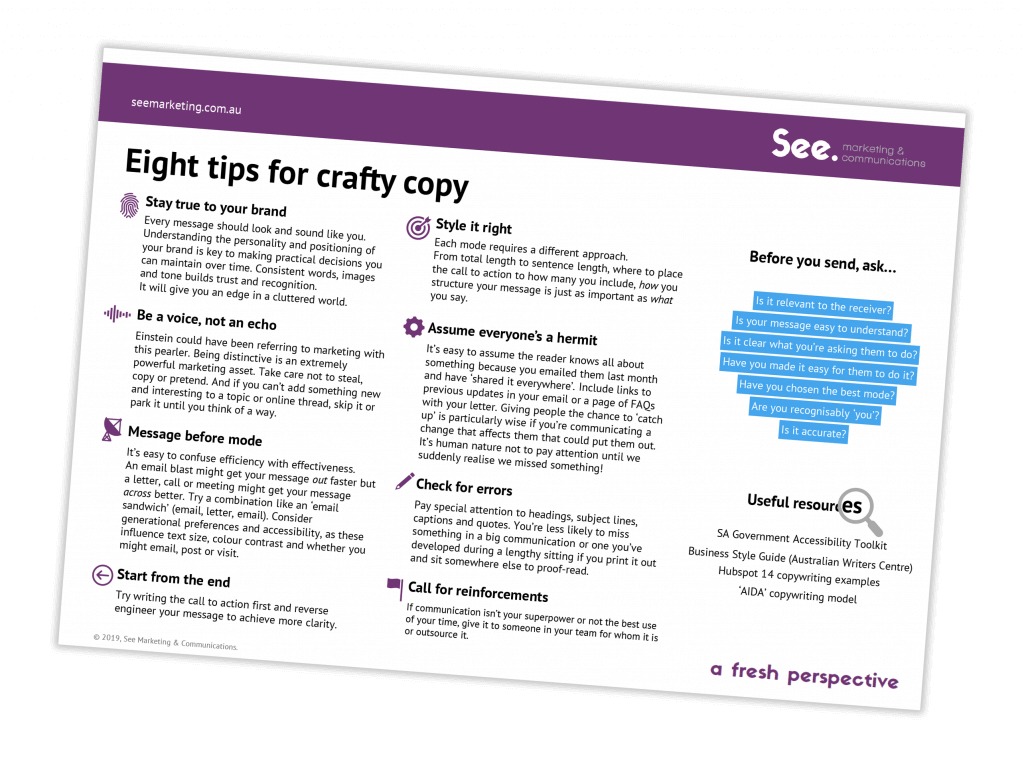If you live in Australia, you might have seen and have an opinion on ‘Don’t Feel Sorry for Old Mate’, part of SA Tourism’s marketing strategy to entice people to cross the border to visit.

As a marketer and crow-eater (South Australian, no idea why), I’ve stayed silent until now.
Partly this is because there were so many passionate opinions flying about at the time and I didn’t think the world needed another one. But it’s also because when we pause, step back and observe, we gain more objective perspectives that can hold practical value for us in our own decision-making.
We don’t yet know how effective the new SA Tourism advertising campaign will be. And while I have an opinion which you can read further on, I’m not here to criticise the work of good people.
But this campaign, and public response to it, is a great opportunity to talk about a few key elements of advertising effectiveness. I hope you find them useful when next thinking about your own advertising campaign.
Oh, and in case you missed it, now would be a good time to watch the campaign in question.
1. Neither cut-through nor awareness is the end game.
A lot of people get hung up on cut-through and awareness. From post-rationalising the success of a charity event as ‘great PR’ when fundraising falls short, to praising advertising campaigns that get shared but don’t translate to runs on the board.
Many people in recent weeks have talked-up the talkability of this ad. And just recently, Tourism Minister David Ridgway was quoted as saying, “It’s actually what the creative people wanted; to talk about the ad.”
Of course cut-through and awareness matter. We’ve never been more bombarded by advertising than we are right now, so if you’re running ads, you want them to be noticed (cut-through). Also, you can’t buy something if you don’t know it exists (awareness).
The problem is, getting people to notice and talk about your ad isn’t all that useful if people don’t also take meaningful action in response to it.
The problem is, getting people to notice and talk about your ad isn’t all that useful if people don’t also take meaningful action in response to it.
Interstaters have heard of South Australia, so awareness isn’t the marketing problem here. And while the tourism ad got people talking – and getting noticed is important – achieving cut-through for its own sake isn’t enough.
As a marketer, I’d be more interested in knowing the answer to questions like these:
- What are people interstate saying about South Australia after seeing the ad?
- When they’re thinking about booking their next holiday, will South Australia spring to mind more readily for more people?
- If so, do they see South Australia as a favourable option?
- Will they be curious enough to look into South Australia as an option?
- And after they do, will more people book and visit? (Mad if they don’t).
Cut-through and awareness are useful. But salience, in this case how likely South Australia will be thought of, and sentiment, being seen as an appealing option for Australians elsewhere to explore when it’s time to book a holiday, are more meaningful metrics.
Key takeout: It doesn’t matter if someone is aware of your brand or the franchise you bought into if when it comes to getting a home loan or getting fit for summer, you’re not even in the mental mix. Or worse, if you’ve managed to make it to their ‘definitely not them’ list because they don’t like your ads.
2. Likeability and effectiveness are cosy bedfellows.
We do business with people we like. We employ people we like. We recommend and buy brands we like. We invite people we like around for BBQs. We marry people we like (even if we unlike them later). We are even programmed to interact with each other online with, you guessed it, likes. If we naturally gravitate towards people and brands and places and products we do like, then it follows that we naturally ignore or avoid those we don’t.
That’s why I’m not a subscriber to the notion that all PR is good PR.
Strong negative experiences and perceptions can be deeply entrenched in our memory. If you’ve ever been put off by something you liked well enough until ‘something happened’, you know how easily one negative experience can overshadow or obliterate your previously held affection. For example, I’ve had a life-long appreciation of eating prosciutto. Until a recent trip to Spain cured me of it (pun intended). What started out as pure joy to find such fresh and cheap pickings, finding myself eating it every other day by choice or because it materialised in the tapas offerings of the local bars, I returned to Adelaide unable to even look at the stuff. Four months on, I still have no idea if I’ll ever eat it again.
Likeability matters in business and life. So too in advertising. Research suggests that ads that are more liked are not only good at building positive brand associations and reinforcing existing ones, but are also more likely to be correctly associated with the brand. Put simply, if someone likes your ad, they’re more likely to like you too and notice you’re the one speaking.
A polarising ad might not be a very big deal for a big brand like South Australia. But if you’re small and the only meaningful action your advert prompts is making someone reach for the remote control or ‘skip ad’ option at the earliest opportunity, then I’m going to say that ad is probably not working for you.
A polarising ad might not be a big deal for a big brand like South Australia. But if you’re small and the only meaningful action your advert prompts is making someone reach for the remote control or ‘skip ad’ option at the earliest opportunity, your ad is probably not working for you.
You can cut-through with a good ad or a bad one. But your aim should be to run effective ads, those that communicate your message clearly, prompt a desired response and enhance rather than detract from your reputation.
Key takeout: Being seen is less important than being seen as an appealing option. Being clear about your advertising objective and realistic about how well the ad aligns with your brand from the market’s perspective, are critical to good results.
3. If your stakeholders don’t like your ad, the campaign is probably doomed.
Early in my marketing career, I learned that opinions – however seemingly misinformed or nonsensical – can kill an otherwise good idea.
I’d commissioned an advertising agency to develop a new campaign and the creative execution they came up with in response to the brief almost, but didn’t completely, sit right. Believing the only opinion that mattered was the market’s, I asked a market research company to run focus groups to test the creative idea before committing to it. The target audience liked it and it didn’t alienate the wider market, so I (naturally) gave it the green light. All was going well… until I rolled the campaign out internally. Two members of senior leadership team disliked it. Immensely. Despite presenting solid evidence of the focus group testing affirming the creative direction, they couldn’t get past their first response.
The campaign did roll out. The market did respond well. But I soon realised the campaign would fail, not because of results but because of the internal dialogue. I’d always believed that no-one can argue with the facts. I learned that people can and often do. Facts are surprisingly subjective.
In the case of the SA Tourism ad, experience tells me that if the tourism sector and the wider public in South Australia aren’t on board, it will be an uphill battle for those responsible to keep it alive. It takes a lot of energy to champion something in the face of stiff internal resistance and whether or not you think the opinions are valid, they do matter. United we stand, divided we fall.
Key takeout: Sometimes, it better to move on than risk taking your eyes off the ball because you’re needing to manage reactions from stakeholders and voices from within. You can learn from it and invest your time and energy in the next one.
Ok, so what do I think about the Old Mate tourism ad?
Personally, I don’t like the ad (sorry creatives). But if it works, I’ll like it a little more. There are two sources of disconnect for me.
1. The humorous overlay jars. Humour can be effective. For eight years, I headed up the national World’s Greatest Shave marketing campaign. There’s nothing fun about losing your hair to cancer. But the event made something painful and traumatic a little lighter somehow. Some people find the chin-people ads annoying, but nothing came close to their effectiveness in driving interest, engagement and sign-ups. Nothing. And the feedback was overwhelmingly positive. Advertising style, humorous or otherwise, has to fit the brand. In ‘Old Mate’, the juxtaposition of a long history of positioning the South Australia brand as a premium food and wine destination and place of insta-worthy landscapes with a lonely figure you might find lurking in the pages of a Dickens novel, feels… well… a bit awkward.
2. There’s a truth I can’t get past. I do feel sorry for Old Mate. Is it just me? Not because he didn’t visit South Australia sooner which is a fair campaign strategy idea. But because of the execution. I wonder if his partner died, if he has a terminal illness, if there’s anyone who cares about him. So being told not to feel sorry for him in a cheerful voice at the end, just makes me feel like there’s something wrong with me. With the brand. With the world. With getting old. They’ve made him real and in some ways relateable. But not in a ‘now is the perfect time to visit South Australia’ kind of way. Rather as a disconnected idea to the notion of travel, an adjunct that is a distraction to the main message.
The intended audience might be talking about it, but only time will tell if the campaign is an effective one. Either way, I do fear that in getting the natives off-side, Old Man might find himself in retirement a little sooner than planned.
Still, I’m just a focus group of one in the wrong geographic location.
If you’d like practical help to make sure your advertising strategy aligns with your marketing strategy, talk to us.



